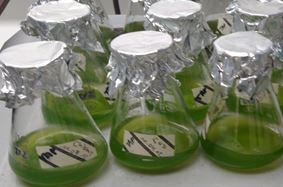Project: nanosecond electro shocks boost algal growth
Background
Energy has to be produced in a sustainable manner. Bioenergy has therefore shifted into focus at the KIT. Algae grow fast and efficiently transduce light into chemical energy. However, the cultivation in biofermenters is still requiring more energy input than it can generate as output. Can we stimulate algal growth to get better yield? Since more than 5 years, we collaborate with the Institute for High Energy Impulse and Microwave Technology (IHM) at the Campus North. This interdisciplinary project deals with the effect of ultrashort electro shocks on plants. These nsPEFs (für nanosecond pulsed electrical fields) produce amazing effects in their plant targes. For instance, a sugar beet can be "persuaded" by such shocks to commit suicide through programmed cell death, such that the sugar can be extracted saving energy otherwise needed for thermic extraction. When the voltage of the nsPEFs is reduced, a curious stimulation of growth is observed. How and why this effect occurs, is unknown. A project funded by the Landesstiftung Baden-Württemberg wants to exploit this effect to boost the growth of microalgae as sustainable source of energy.

